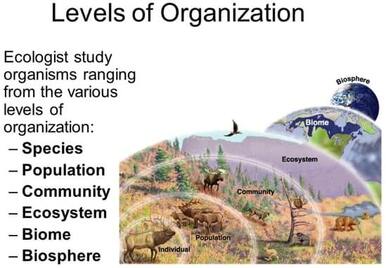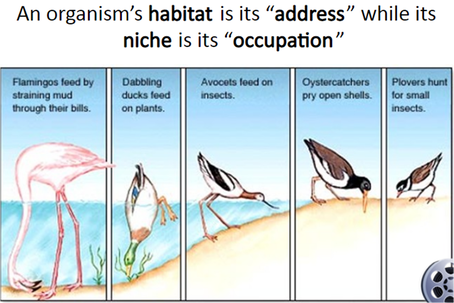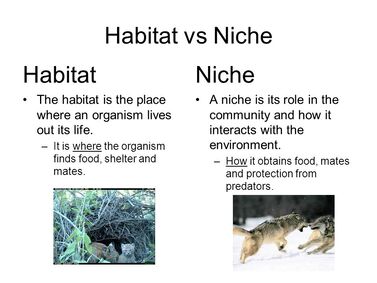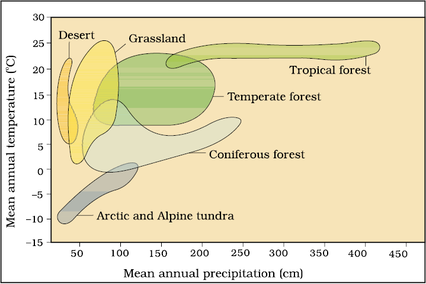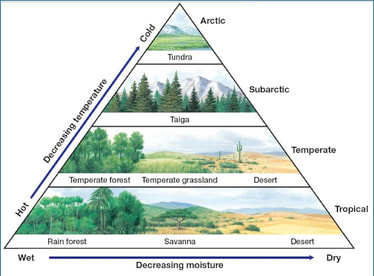13. Organisms and populations
Scope of the syllabus:
Organisms and environment: habitat and niche, population and ecological adaptations; population interactions - mutualism, competition, predation, parasitism; population attributes - growth, birth rate and death rate, age distribution.
Definition of ecology; major biomes; abiotic factors (temperature, water, light, soil – definition of stenothermal, eurythermal, stenohaline and euryhaline), responses to abiotic factors (regulate, conform, migrate, suspend); ecological adaptations: morphological, physiological and behavioural in response to loss of water and extremes of temperature in plant and animals including humans. Definition of habitat and niche.
Definition of population; population attributes: sex ratio, types of age distribution pyramids for human population; definition of population density, natality, mortality, emigration, immigration, carrying capacity. Ways to measure population density. Calculation of natality and mortality.
Population growth: factors affecting population growth and population growth equation; growth models: exponential growth and logistic growth along with equations, graph and examples of the same; life history variations: definition of reproductive fitness and examples.
Population interactions – definition of mutualism, competition (interspecific, interference, competitive release and Gause’s Principle of Competitive Exclusion), predation (adaptations in organisms to avoid predation), parasitism (ecto-, endo-, and brood parasites), commensalism, amensalism with examples of each.
Organisms and environment: habitat and niche, population and ecological adaptations; population interactions - mutualism, competition, predation, parasitism; population attributes - growth, birth rate and death rate, age distribution.
Definition of ecology; major biomes; abiotic factors (temperature, water, light, soil – definition of stenothermal, eurythermal, stenohaline and euryhaline), responses to abiotic factors (regulate, conform, migrate, suspend); ecological adaptations: morphological, physiological and behavioural in response to loss of water and extremes of temperature in plant and animals including humans. Definition of habitat and niche.
Definition of population; population attributes: sex ratio, types of age distribution pyramids for human population; definition of population density, natality, mortality, emigration, immigration, carrying capacity. Ways to measure population density. Calculation of natality and mortality.
Population growth: factors affecting population growth and population growth equation; growth models: exponential growth and logistic growth along with equations, graph and examples of the same; life history variations: definition of reproductive fitness and examples.
Population interactions – definition of mutualism, competition (interspecific, interference, competitive release and Gause’s Principle of Competitive Exclusion), predation (adaptations in organisms to avoid predation), parasitism (ecto-, endo-, and brood parasites), commensalism, amensalism with examples of each.
Ecology : Introduction
|
Levels of organisation
- To enhance the understanding of nature, scientists classify matter into levels of organization from atoms to the biosphere.
- Ecologists focus on organisms, populations, communities, ecosystems, and the biosphere.
- Organism : Organism is an individual living being that has the ability to act or function independently. It is the basic unit of study in ecology.
- Species : Species are groups o€ organisms that can potentially interbreed to produce €ertile ofspring.
- Population : Group of organisms belonging to the same species that live in the same area and interact with one another.
- Community : All of the populations of different species that live in the same area and interact with one another.
- Ecosystem : All the living things (biotic) in an area interacting with all of the non-living parts (abiotic) of the environment.
- Biome : Ecosystems with similar climate (temperature and precipitation levels) and types of biotic factors.
- Biosphere :Region of the Earth that is home to living things.
Self assessment 1: Check you understanding
Organism and its environment
ENVIRONMENT :
- The environment is the sum total of all biotic and abiotic factors that surround and potentially influence an organism.
- The surroundings or conditions in which a person, animal, or plant lives or operates.
WEATHER AND CLIMATE
- Weather is a local area’s short-term temperature, precipitation, humidity, wind speed, cloud cover, and other physical conditions as measured over hours or days.
- Climate is an area’s general pattern of atmospheric or weather conditions measured over long periods of time ranging from decades to thousands of years.
- As American writer and humorist Mark Twain once said, “Climate is what we expect, weather is what we get.”
HABITAT AND NICHE
Habitat:
- The place or set of environmental conditions in which an organism lives.
- Regional and local variations within each biome lead to the formation of a wide variety of habitats.
- The key elements that lead to so much variation in the physical and chemical conditions of different habitats are abiotic (temperature, water, light and soil) and biotic components (pathogens, parasites, predators and competitors)
- Examples:
- On planet Earth, life exists not just in a few favourable habitats but even in extreme and harsh habitats – scorching Rajasthan desert, perpetually rain-soaked Meghalaya forests, deep ocean trenches, torrential streams, permafrost polar regions, high mountain tops, boiling thermal springs, and stinking compost pits, to name a few.
- Even our intestine is a unique habitat for hundreds of species of microbes.
NICHE :
- Niche is the positional status of an organism in an ecosystem. or The role of an organism or population within an ecosystem.
- Niche reflects it biotic and abiotic association with the environment in terms of its diet, reproduction, and other activities
- Habitat of an organism is its address and niche is its profession or lifestyle.
- The niche of an organism determines
i)The range of conditions, it can tolerate
ii)The resources which it can utilize
iii) The role it plays in the ecosystem
Self assessment 2: H for Habitat, N for Niche.
- ______A mouse lives in a tree trunk.
- ______Hyenas eat dead animals and small rodents.
- ______Some birds fly south in the winter and eat insects when they get there.
- ______The Hyenas stay in a cave.
- ______Some birds live in the tops of the trees in a nest.
- ______A mouse is eaten by snakes and eats grass.
MAJOR BIOMES
- Ecosystems with similar climate (temperature and precipitation levels) and types of biotic factors.
- The rotation of our planet around the sun and the tilt of its axis cause annual variations in the intensity and duration of temperature, resulting in distinct seasons.
- These variations together with annual variation in precipitation (remember precipitation includes both rain and snow) account for the formation of major biomes.
- Not all scientists classify biomes in the same way. Some use broad classifications and count as few as six biomes. These are forest, grassland, freshwater, marine, desert, and tundra. Other scientists use more precise classifications and list dozens of different biomes
- Major biomes of the world:
- Arctic and alpine tundra
- Desert
- Tropical forest
- Grassland
- Temperate forest
- Coniferous forest
- Major biomes of India :
- Tropical rain forest
- Deciduous forest
- Desert
- Sea coast
MAJOR ABIOTIC FACTORS
RESPONSE TO ABIOTIC FACTORS
ADAPTATIONS

